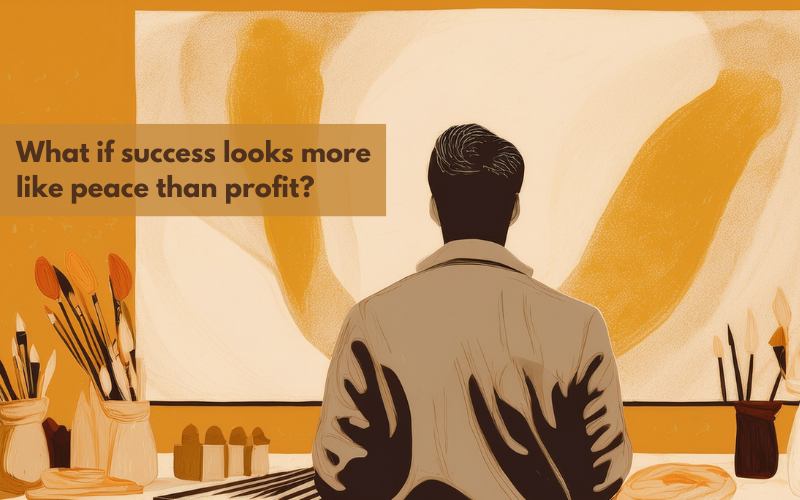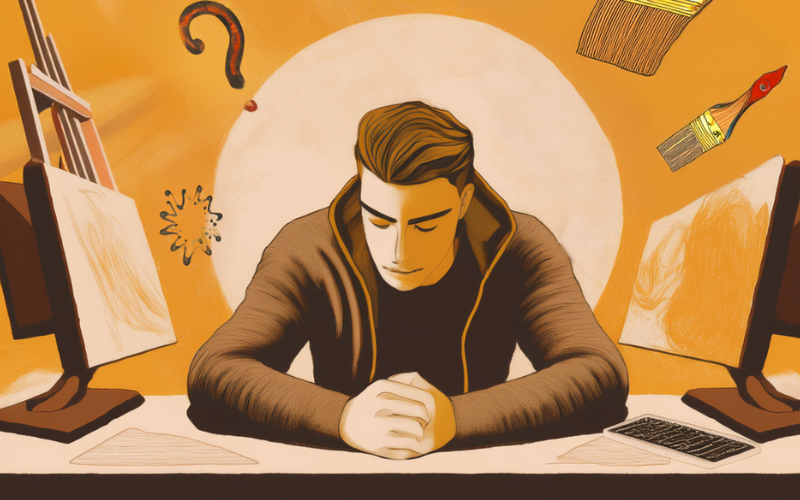Welcome to Ask Artwork Archive, a space where we explore the messy, emotional, and often unspoken parts of being an artist.
This week, we’re responding to an artist who’s been making art for years—but finds themselves exhausted by the pressure to turn it into a business. They’re wondering if they’re even cut out for this, struggling with burnout, pricing, and questioning whether their work still matters in a world that feels increasingly disconnected from the value of human-made art.
Their words speak to a deeper ache—how to keep going when you’re unsure what you’re working toward, and the tension between creating from a place of meaning and trying to make that work visible—or sellable.
If you’ve ever felt blocked, disillusioned, or unsure whether you want to keep putting your art out there, this one's for you.
We’re talking about what it means to be an artist in a noisy, demanding world—and how to reconnect with your work, even if you’re not ready to sell it.

Dear Artwork Archive,
I'm burnt out from trying to turn my art into a business. And I'm starting to wonder if I'm even cut out for it.
I've been making art for years—not for profit, but because it helps me process life. It's how I reflect, reconnect with myself, and make sense of the world. Overtime, that's led to a large collection of work. But when it comes to selling it...
I just feel...blocked. Unmotivated. Frustrated.
What people are willing to pay feels worlds apart from what I've poured into each piece. It's disheartening. And sometimes, it makes me want to stop putting my work out there altogether.
Also, the rise of AI-generated art and image scraping makes things even harder. It feels like the value of human-made work is shrinking, and I don't know how to keep going in a world that doesn't seem to see the worth in what we do as artists.
I guess I'm struggling with what success even looks like anymore. I know it's not about money—though that's obviously useful. I think it's more of a feeling that I just can't seem to grasp. A feeling of hope? Peace? Maybe even flow? I keep searching for that sweet spot where everything clicks, but the art world is noisy and feels broken.
I want to feel like my work matters, even if no one buys it.
I want to believe that being an artist can still mean something in today's world that moves so fast and forgets so easily. And maybe part of me still wants to explore what it might look like to turn my art into a business—but only if there's a way to do that while staing genuinely connected to what brought me here in the first place.
I'm not sure any advice could bring me these things...but I'm still asking.
Sincerely,
Tired, But Not Done

Dear Not Done,
Thank you for putting into words what so many artists carry the weight of but rarely say out loud. We guarantee you most creatives are nodding along.
Burnout—especially when it comes from trying to turn something so personal into something transactional—isn’t a failure. It’s a very human response. What you're feeling doesn’t mean you’re not cut out for this industry. It’s a sign of someone who feels deeply, who cares about what they’re making, and who hasn’t stopped paying attention to what matters.
What you’re feeling when it comes to pricing is so real—and so common. When your art is met with offers that feel dismissive, it can absolutely create a kind of doubt that’s hard to shake. But we want to encourage you here: you can find a way to price that feels right—in your head AND your gut.
Start by experimenting. Play with different structures until you find one that reflects your time, your materials, your story, and the years it took to get here.
We’ve talked to artists all over the world, and so many have found their pricing groove by starting with a formula—and then claiming it with confidence. You don’t have to stay stuck at one price forever. You get to grow. You should grow. And your pricing can grow with you.
Someone out there is waiting for your work. And they’ll pay the right price—because they’ll feel the value in it.
We’ll also say this plainly: You don’t have to sell your work. Not now. Not ever. It’s okay if you never do. It’s okay if you return to the idea someday with new boundaries, or if you redefine what business and success even mean to you. You can opt out of the market and still honor your practice. You can build a body of work that nobody sees for years, and it will still be valid. Your existence as an artist isn’t tied to how many red dots you rack up.
You mentioned how AI-generated art and image scraping have made it harder to feel like human-made work holds its place. That’s a very real concern—and one we hear from artists more and more.
But we believe, wholeheartedly, that art made by human hands—anchored in memory, time, context, material, and imperfection—will always matter. At least in our book. And we’d be willing to bet that most of humanity still feels that way too, even if the headlines suggest otherwise.
There are ways to protect your work—through image settings, watermarking, and privacy tools—but perhaps the bigger protection is knowing this: AI can mimic. It can remix.
But AI can’t originate art like you can.
It doesn’t dream up ideas in the shower. It doesn’t lie awake haunted by a concept. It doesn’t wrestle with doubt, or joy, or memory. AI doesn’t get a rush of inspiration from a fleeting smell that reminds you of your childhood home. Only you do that. Only humans do that. And that’s what humans connect most with.
You wrote about longing for flow, for peace, for something you can’t quite name. That kind of longing is powerful, and it’s probably what lead you to making art in the first place.
Start by documenting your work—just for you. It can be one of the ways to reconnect with that feeling.
You don’t have to list it for sale. You don’t have to show it to anyone. Sometimes, the quiet act of naming what you’ve made, organizing it, and reflecting on what you’ve made helps you reclaim your story and your legacy as an artist.
It’s how you say: This mattered. Even if no one bought it. Even if no one even saw it but you.
And if there comes a time when you do want to share your work—or sell it—on your own terms, there are tools built exactly for that. Built by and for artists who’ve stood right where you are.
But for now? Keep making. Or rest. Or walk outside. Touch the materials again when you’re ready. Give yourself what you’re asking for: space, quiet, gentleness.
This world might be noisy, but your art doesn’t have to prove anything. And neither do you.
We’re really glad you reached out.
Always here,
Artwork Archive
Have a sticky situation in your art business you're trying to navigate?
Whether you're wrestling with pricing questions, client communications, gallery relationships, or those delicate professional boundaries—we know running an art business comes with unique challenges.
Have a situation in your art career keeping you up at night? A professional puzzle you'd love help solving? Share your question through the form below. You could get the guidance you're seeking, and your experience might just help fellow artists navigate similar waters!
We're all in this creative journey together, and some of the best solutions come from our shared experiences.
We look forward to hearing from you!







